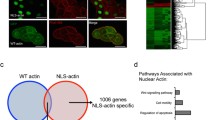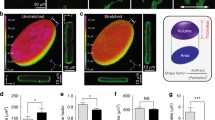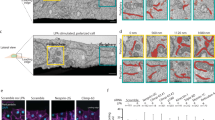Abstract
To evaluate the role of actin cytoskeleton in the regulation of NF-κB transcription factor, we analyzed its involvement in the intracellular transport and nuclear translocation of the NF-κB RelA/p65 subunit in A431 epithelial cells stimulated with fibronectin and EGF. Live cell imaging and confocal microscopy showed that EGF activated the movement of RelA/p65 in the cytoplasm. Upon cell adhesion to fibronectin, RelA/p65 concentrated onto stress fibers, and EGF stimulated its subsequent allocation to membrane ruffles, newly organized stress fibers, and discrete cytoplasmic actin-rich patches. These patches also contained α-actinin-1 and α-actinin-4, vinculin, paxillin, α-tubulin, and PI3-kinase. Cytochalasin D treatment resulted in RelA/p65 redistribution to actin-containing aggregates, with the number of cells with RelA/p65-containing clusters in the cytoplasm increasing under the effect of EGF. Furthermore, EGF proved to induce RelA/p65 accumulation in the nucleus after cell pretreatment with actin-stabilizing and actin-destabilizing agents, which was accompanied by changes in its DNA-binding activity after either EGF stimulation or cytochalasin D treatment. Thus, EGF treatment of A431 cells results in simultaneous nuclear RelA/p65 translocation and cytoplasmic redistribution, with part of RelA/p65 pool forming a very tight association with actin-rich structures. Apparently, nuclear transport is independent on drug stabilization or destabilization of the actin.






Similar content being viewed by others
References
Anes V, Cogswell P, Baldwin A (2004) IkappaB kinase α and p65/RelA contribute to optimal epidermal growth factor-induced c-fos gene expression independent of IkappaB degradation. J Biol Chem 279:31183–31189
Are A, Galkin V, Pospelova T, Pinaev G (2000) The p65 of NF-kappaB interacts with actin-containing structures. Exp Cell Res 256:533–544
Are A, Pinaev G, Burova E, Lindberg U (2001) Attachment of A-431 cells on immobilized antibodies to the EGF receptor promotes cell spreading and reorganization of the microfilament system. Cell Motil Cytoskel 48:24–36
Babakov V, Petukhova O, Turoverova L, Kropacheva I, Tentler D, Bolshakova A, Podolskaya E, Magnusson K-E, Pinaev G (2008) RelA/NF-kappaB transcription factor associates with alpha actinin-4. Exp Cell Res 314:1030–1038
Birbach A, Gold P, Binder B, Hofer E, Martin R, Schmid J (2002) Signaling molecules of the NF kappa B pathway shuttle constitutively between cytoplasm and nucleus. J Biol Chem 277:10842–10851
Bolshakova A, Magnusson K-E, Pinaev G, Petukhova O (2013) Functional compartmentalization of NF-κB-associated proteins in A431 cells. Cell Biol Int 9999:1–10
Bubb M, Spector I, Beyer B, Fosen K (2000) Effects of Jasplakinolide on the kinetics of actin polymerization. J Biol Chem 275:5163–5170
Campbel E, Hope T (2003) Role of cytoskeleton in the nuclear import. Adv Drug Deliv Rev 55:761–771
Chen LF, Fischle W, Verdin E, Greene WC (2001) Duration of nuclear NF-kappaB action regulated by reversible acetylation. Science 293:1653–1657
Chhabra E, Higgs H (2007) The many faces of actin: matching assembly factors with cellular structures. Nat Cell Biol 9:1110–1121
Clark K, McElhinny A, Beckerle M, Gregorio C (2002) Striated muscle cytoarchitecture: an intricate web of form and function. Ann Rev Cell Dev Biol 18:637–706
Davis J, Bennett V (1984) Brain ankyrin. A membrane-associated protein with binding sites for spectrin, tubulin, and the cytoplasmic domain of the erythrocyte anion channel. J Biol Chem 25:13550–13559
De Lorenzi R, Gareus R, Fengler S, Pasparakis M (2009) GFP-p65 knock-in mice as a tool to study NF-κB dynamics in vivo. Genesis 47:323–329
Emelyanov A, Petukhova O, Turoverova L, Kropacheva I, Pinaev G (2006) Dynamic of DNA binding activity of transcription factors in A431 cells during their spreading on immobilized ligands. Tsitologiya 48:935–947
Fagerlund R, Kinnunen L, Kohler M, Julkunen I, Melen K (2005) NF-kappaB is transported into the nucleus by importin α3 and importin α4. J Biol Chem 280:15942–15951
Fazal F, Minhajuddin M, Bijli K, McGrath J, Rahman A (2007) Evidence for actin cytoskeleton-dependent and -independent pathways for RelA/p65 nuclear translocation in endothelial cells. J Biol Chem 282:3940–3950
Geiger B, Bershadsky A, Pankov R, Yamada K (2001) Transmembrane extracellular matrix-cytoskeleton crosstalk. Nat Rev Mol Cell Biol 2:793–805
Ghosh S, Karin M (2002) Missing pieces in the NF-kappaB puzzle. Cell 109(Suppl):S81–S96
Hynes R (1999) Cell adhesion: old and new questions. Trends Cell Biol 9:33–37
Johnson C, Van Antwerp D, Hope T (1999) An N-terminal export signal is required for nucleocytoplasmic shuttling of IκBα. EMBO J 18:6682–6693
Karki S, Holzbaur E (1999) Cytoplasmic dynein and dynactin in cell division and intracellular transport. Curr Opin Cell Biol 11:45–53
Kustermans G, El Benna J, Piette J, Legrand-Poels S (2005) Perturbation of actin dynamics induces NF-kappa B activation in myelomonocytic cells through an NADH oxidase-dependent pathway. Biochem J 387:531–540
Kustermans G, El Mjiyad N, Horion J, Jacobs N, Piette J, Legrand-Poels S (2008a) Actin cytoskeleton differentially modulates NF-kappaB-mediated IL-8 expression in myelomonocytic cells. Biochem Pharmacol 76:1214–1228
Kustermans G, Piette J, Legrand-Poels S (2008b) Actin-targeting natural compounds as tools to study the role of actin cytoskeleton in signal transduction. Biochem Pharmacol 76:1310–1322
Linder S, Aepfelbacher M (2003) Podosomes: adhesion hot-spots of invasive cells. Trends Cell Biol 13:376–385
Merzlyak E, Goedhart J, Shcherbo D, Bulina M, Shcheglov A, Fradkov A et al (2007) Bright monomeric red fluorescent protein with an extended fluorescence lifetime. Nat Methods 4:555–557
Miralles F, Posern G, Zaromytidou A, Triesman R (2003) Actin dynamics control SRF activity by regulation of its coactivator. Mal Cell 113:329–342
Nemeth Z, Deitch E, Davidson M, Szabo C, Vizi E, Hasko G (2004) Disruption of the actin cytoskeleton results in nuclear factor-kappaB activation and inflammatory mediator production in cultured human intestinal epithelial cells. J Cell Physiol 200:71–81
Olson E, Nordheim A (2010) Linking actin dynamics and gene transcription to drive cellular motile functions. Nat Rev Mol Cell Biol 11:353–365
Petukhova O, Turoverova L, Kropacheva I, Pinaev G (2004) Morphological peculiarities of epidermoid carcinoma A431 cells spread on immobilized ligands. Tsitologiya 46:5–15
Petukhova O, Turoverova L, Emelyanov A, Kropacheva I, Pinaev G (2005) SRE, NF-κB, and AP-1 DNA-binding activities induced by A431 cell adhesion correlate with actin cytoskeleton reorganization. Tsitologiya 47:175–183
Porquet N, Poirier A, Houle F, Pin A, Gout S, Tremblay P et al (2011) Survival advantages conferred to colon cancer cells by E-selectin-induced activation of the PI3K-NFκB survival axis downstream of Death receptor-3. BMC Cancer 11:285
Reddy S, Huang J, Liao W (1997) Phosphatidylinositol 3-kinase in interleukin 1 signaling. Physical interaction with the interleukin 1 receptor and requirement in NFkappaB and AP-1 activation. J Biol Chem 272:29167–29173
Riedl J, Crevenna A, Kessenbrock K, Yu J, Neukirchen D, Bista M et al (2008) Lifeact: a versatile marker to visualize F-actin. Nat Methods 5:605–607
Shih V, Tsui R, Caldwell A, Hoffmann A (2011) A single NFκB system for both canonical and non-canonical signaling. Cell Res 21:86–102
Sizemore N, Leung S, Stark G (1999) Activation of phosphatidylinositol 3-kinase in response to interleukin-1 leads to phosphorylation and activation of the NF-kappaB p65/RelA subunit. Mol Cell Biol 19:4798–4805
Sotiropoulos A, Gineitis D, Copeland J, Treisman R (1999) Signal-regulated activation of serum response factor is mediated by changes in actin dynamic. Cell 98:159–169
Varon C, Tatin F, Moreau V, Van Obberghen-Schilling E, Fernandez-Sauze S, Reuzeau E et al (2006) Transforming growth factor β induces rosettes of podosomes in primary aortic endothelial cells. Mol Cell Biol 26:3582–3594
Wan F, Lenardo M (2010) The nuclear signaling of NF-κB: current knowledge, new insights, and future perspectives. Cell Res 20:24–33
Wolfenson H, Henis YI, Geiger B, Bershadsky AD (2009) The heel and toe of the cell’s foot: a multifaceted approach for understanding the structure and dynamics of focal adhesions. Cell Motil Cytoskeleton 11:1017–1029
Zaidel-Bar R, Itzkovitz S, Ma’ayan A, Iyengar R, Geiger B (2007) Functional atlas of the integrin adhesome. Nat Cell Biol 9:858–867
Zhu P, Xiong W, Rodgers G, Qwarnstrom E (1998) Regulation of interleukin 1 signalling through integrin binding and actin reorganization: disparate effects on NF-kappaB and stress kinase pathways. Biochem J 330:975–981
Acknowledgments
We are grateful to Dr. Theodorus Gadella (Section of Molecular Cytology, van Leeuwenhock Centre for Advanced Microscopy, Swammerdam Institute of Life Sciences, University of Amsterdam, Amsterdam, The Netherlands) for kindly supplying us with the ptagRFP-LifeAct vector. This research was supported by Grants from the Swedish Institute [Visby program 879/2009], Swedish Research Council [2010-3045], postdoctoral fellowship at the Faculty of Health Science, Linköping University (to A.B.), European Science Foundation (TraPPs Euromembrane project), Molecular and Cellular Biology Program of Russian Academy of Sciences, and Russian Foundation for Basic Research [13-04-00497].
Author information
Authors and Affiliations
Corresponding author
Electronic supplementary material
Below is the link to the electronic supplementary material.
Supplementary Video: A431 cell transfected with GFP-RelA/p65 (green) and tagRFP-LifeAct (red) vectors. Images were taken of cells spread on fibronectin for 1 h and then treated with EGF (100 ng/ml). Time between frames was 30 sec. During attachment to fibronectin, the cells acquired a polygonal shape and a fine microfibrillar banding pattern throughout the cell body. Subsequent EGF stimulation resulted in F-actin reorganization with the formation of distinct lamellae within 5–15 min and their subsequent shortening by 30 min after adding EGF. The results of live cell imaging (epifluorescence and optical section images) are presented. In epifluorescent images (on the left), the fluorescence intensity of RelA/p65 in the lamella is increased after EGF stimulation, indicating p65 translocation to this area (MPEG 1108 kb)
Rights and permissions
About this article
Cite this article
Bolshakova, A., Magnusson, KE., Pinaev, G. et al. EGF-induced dynamics of NF-κB and F-actin in A431 cells spread on fibronectin. Histochem Cell Biol 144, 223–235 (2015). https://doi.org/10.1007/s00418-015-1331-5
Accepted:
Published:
Issue Date:
DOI: https://doi.org/10.1007/s00418-015-1331-5




